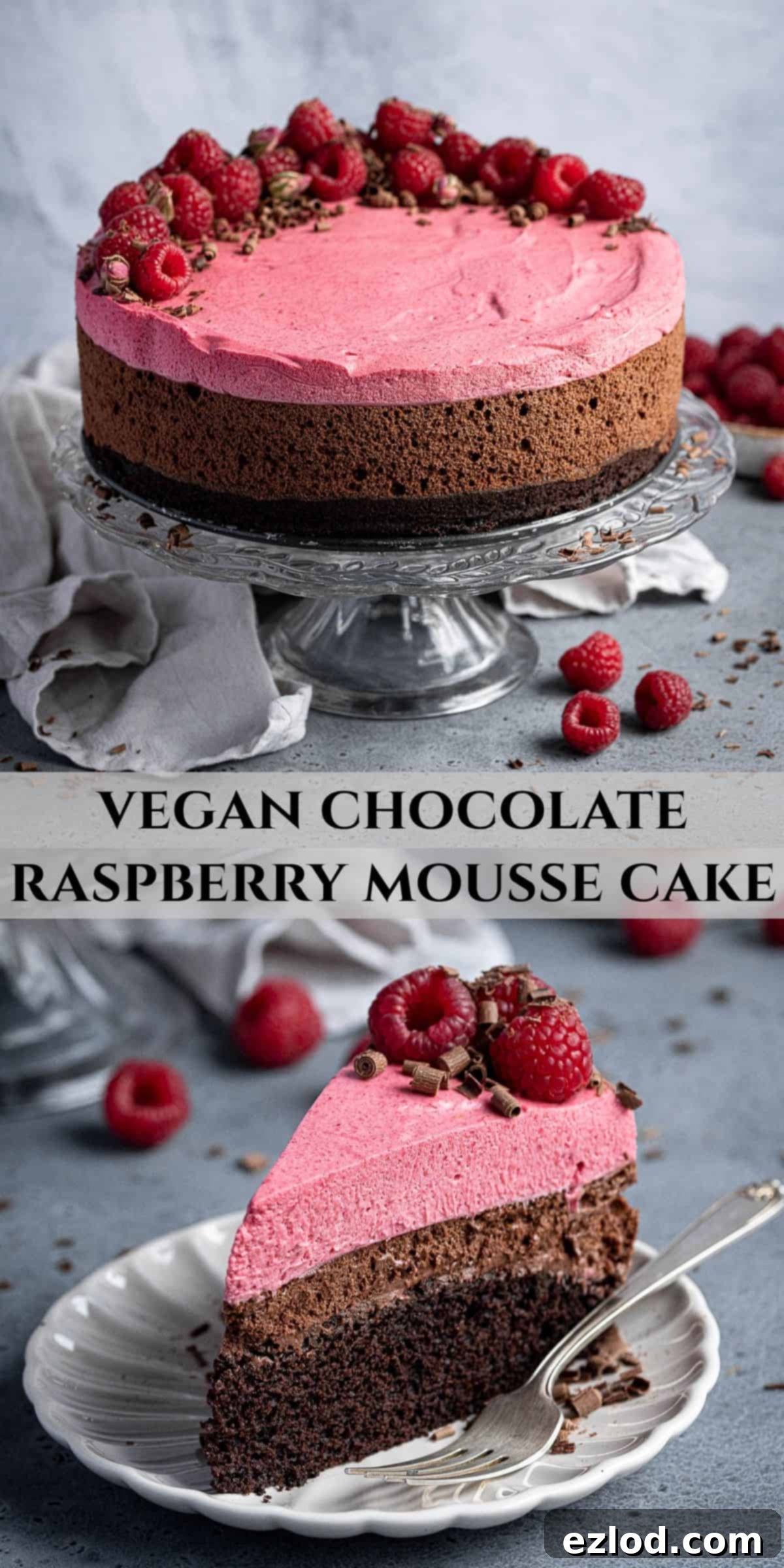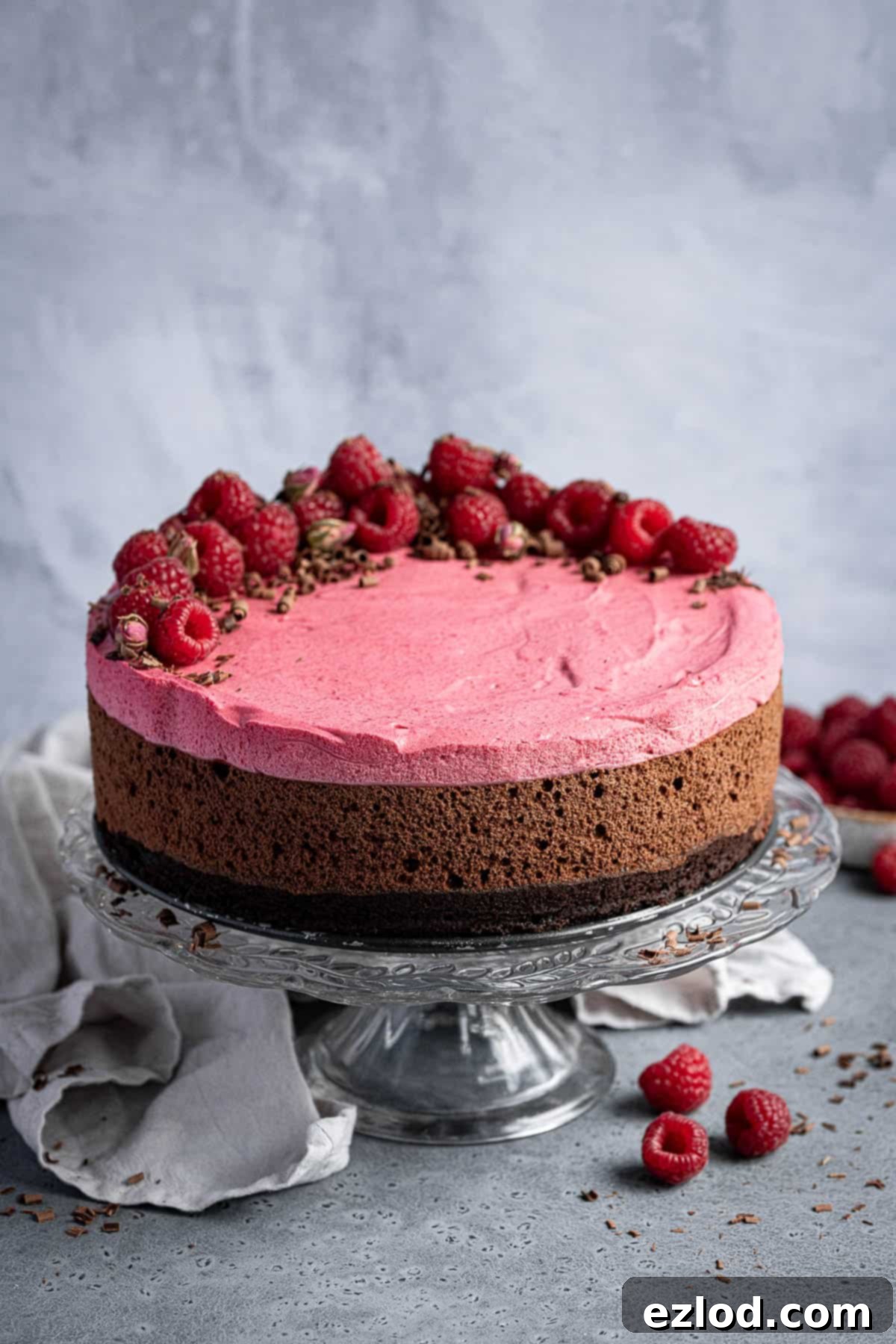Decadent Vegan Chocolate Raspberry Mousse Cake: A Luxurious Plant-Based Dessert
Prepare to be enchanted by the **Vegan Chocolate Raspberry Mousse Cake** – a truly spectacular dessert that combines layers of rich, intense dark chocolate mousse with a vibrant, tangy vegan white chocolate raspberry mousse, all resting atop a wonderfully moist and fluffy chocolate cake base. This creation is more than just a dessert; it’s a celebration in every slice, guaranteed to impress and delight even the most discerning palates, whether they’re vegan or not.
This indulgent treat strikes a perfect balance: it’s undeniably luxurious and visually stunning, yet surprisingly light and airy. The bold, deep flavors of the dark chocolate are beautifully complemented by the bright, fruity tang of the raspberry, creating a harmonious taste experience that is both satisfying and refreshing. It’s the perfect showstopper for any special occasion, from birthdays to holiday gatherings, or simply when you want to treat yourself and your loved ones to something extraordinary.
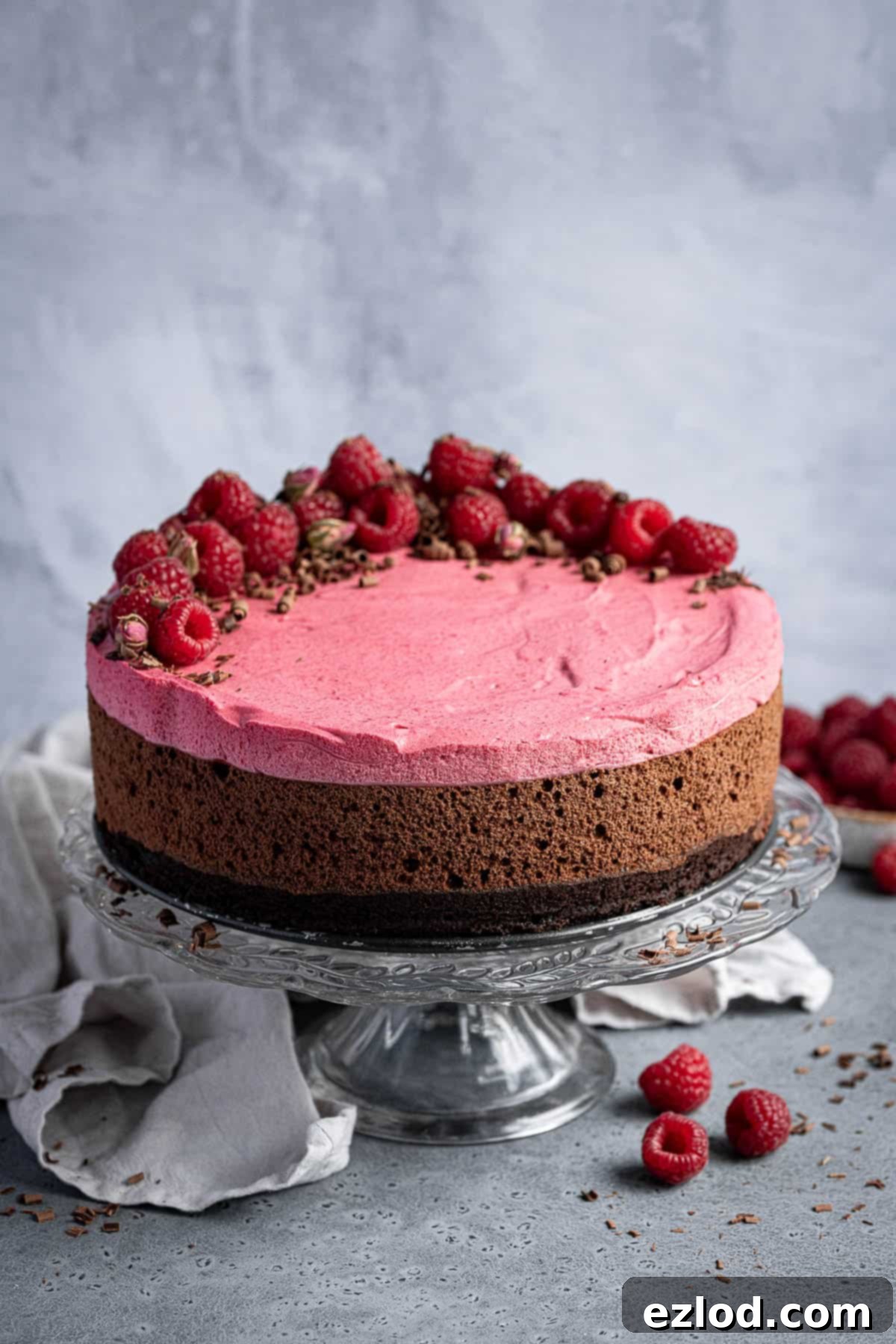
Creating this vegan chocolate raspberry mousse cake might just become one of your favorite baking achievements. Its impressive height and contrasting layers of color and texture make it a feast for the eyes before you even take the first bite. Despite its complex appearance, the recipe is broken down into manageable steps, allowing you to craft this masterpiece in your own kitchen. The ethereal lightness of the mousse layers ensures it’s a delicious, satisfying, yet never overly heavy conclusion to any meal.
The journey to crafting this stunning cake involves three distinct components: a tender chocolate cake base, a rich and velvety dark chocolate mousse, and a bright and fruity white chocolate raspberry mousse. Each layer contributes uniquely to the overall experience, ensuring a symphony of flavors and textures with every forkful. Let’s dive into the essential ingredients you’ll need to bring this magnificent dessert to life.
Key Ingredients for Your Vegan Chocolate Raspberry Mousse Cake:
To successfully create this layered masterpiece, understanding the role of each ingredient is crucial. Here’s a breakdown of what you’ll need and why specific choices are recommended for the best results:
- Vegan Whipping Cream: This is a cornerstone for both mousse layers. I highly recommend Elmlea plant double cream if you are in the UK, as it whips beautifully and provides an excellent texture. For those outside the UK, seek out a vegan cream specifically designed for whipping, not a pouring cream. Some brands offer excellent plant-based heavy creams that perform similarly. While coconut cream can sometimes work, it’s important to note that it hasn’t been extensively tested for this recipe, and its flavor can be more pronounced, potentially affecting the delicate balance of the mousses. You will need **two** tubs or containers for the recipe.
- Aquafaba: The liquid from canned chickpeas, aquafaba, is a magical vegan egg white substitute. For optimal stability and quicker whipping, it’s best to use either reduced and cooled aquafaba (instructions below) or a commercial, pre-reduced version like Oggs (my personal preference). Aquafaba directly from the can can be less stable and take longer to reach stiff peaks, making reduction a worthwhile step.
- Agar Agar Powder: This plant-based gelling agent is absolutely essential for the white chocolate raspberry mousse to set correctly and achieve its delicate yet stable texture. Ensure you use **agar agar powder**, not flakes, as their setting strengths and usage ratios differ significantly. Agar agar needs to be boiled for a couple of minutes to activate its gelling properties.
- Chocolate: You’ll need two types of vegan chocolate for contrasting flavors.
- Dark Chocolate: For the rich chocolate mousse, choose a dark chocolate with no more than 70% cocoa solids. Chocolates with higher percentages can be more temperamental when melted, potentially seizing or becoming grainy, especially when combined with liquid.
- Vegan White Chocolate: This forms the base of the raspberry mousse. Brands vary in quality and melting properties, so choose a reliable one. Sainsbury’s Free From is a good option if available to you. Ensure it’s a vegan white chocolate that melts smoothly.
- Raspberries: I typically use defrosted frozen raspberries. They are not only more cost-effective but also readily available year-round, providing a consistent tartness and flavor. Fresh raspberries can also be used, but you might need a slightly larger quantity to get enough puree, and they can be more expensive.
- Cream of Tartar: This acidic ingredient is crucial for stabilizing the aquafaba as it whips, helping it reach and maintain stiff peaks. If you don’t have cream of tartar, a small amount of white vinegar can be used as a substitute, serving a similar purpose.
- Sugar: Both caster (superfine) sugar and icing (powdered) sugar are specified. Caster sugar dissolves easily in the cake batter and aquafaba, while icing sugar helps achieve a smooth texture in the whipped cream. While you can substitute caster sugar for icing sugar in the cream if needed, granulated sugar is not recommended as its larger crystals may not fully dissolve, leading to a slightly grainy mousse.
- Lemon Juice: A touch of fresh lemon juice in the raspberry mousse helps to brighten and intensify the natural raspberry flavor, enhancing its tanginess and providing a lovely contrast to the sweetness of the white chocolate.
- Non-Dairy Milk: For the moist chocolate cake base, any unsweetened non-dairy milk will work. However, soy milk is often preferred in vegan baking due to its protein content, which can contribute to a richer crumb and better structure. Almond or oat milk are also suitable alternatives.
- Neutral Flavored Oil: A neutral oil, such as sunflower or canola, is ideal for the cake, providing moisture without imparting any strong flavors. If you prefer, a light olive oil or avocado oil can also be used, but ensure they don’t have an overpowering taste.
- Vinegar (for cake): In vegan baking, vinegar (often apple cider vinegar) reacts with baking soda to create carbon dioxide, which acts as a leavening agent. This reaction helps to make the chocolate cake light, fluffy, and tender.
- Plain (All-Purpose) Flour: Regular plain flour provides the structure for the cake. If you need a gluten-free option, a good quality plain gluten-free flour blend should work. For best results with gluten-free flour, consider adding about ¼ teaspoon of xanthan gum to help with elasticity and structure, as gluten-free flours often lack the binding properties of wheat flour.
- Cocoa Powder: Use a Dutch-processed cocoa powder for a deeper, darker chocolate flavor and color in your cake. For those in the UK, this is typically just labeled as “cocoa powder” in most supermarkets.
- Vanilla Extract: For the most authentic and rich vanilla flavor, always opt for pure vanilla extract rather than artificial vanilla essence.
- Baking Powder and Bicarbonate of Soda (Baking Soda): The cake recipe utilizes both of these leavening agents. They work in conjunction to create the perfect rise and crumb texture. Do not swap one for the other, as they react differently and both are needed for the best outcome.
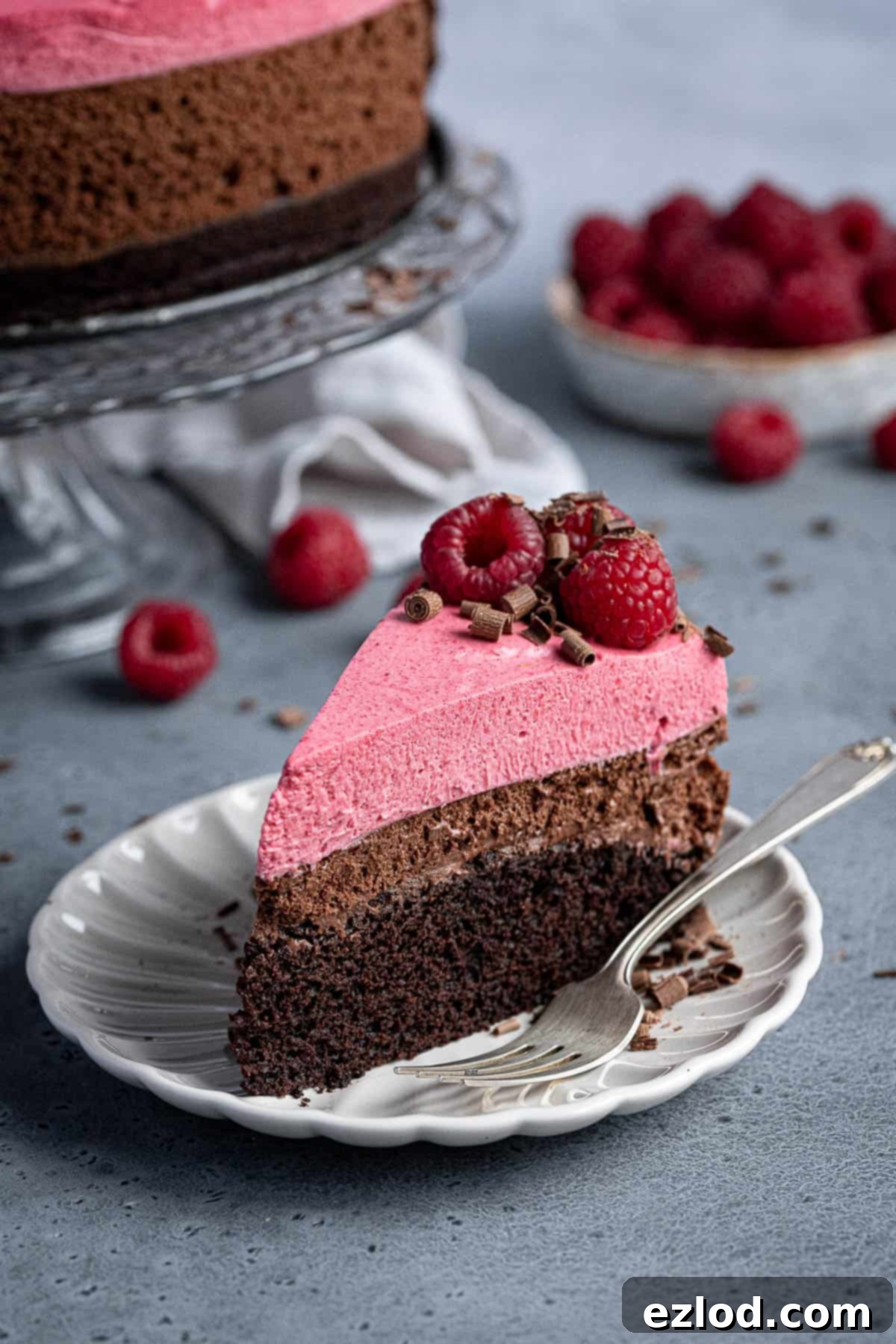
Crafting Your Vegan Chocolate Raspberry Mousse Cake: A Step-by-Step Guide
Making this beautiful cake is a rewarding process. While it requires a bit of time and patience, following these steps will lead you to a truly stunning result. Remember that patience, especially during chilling times, is key!
(Detailed measurements and full instructions are provided in the comprehensive recipe card at the bottom of this page.)
Building the Chocolate Cake Base:
Begin by preparing your chocolate cake. This forms the sturdy and delicious foundation for your mousse layers. In a medium bowl, whisk together the wet ingredients: non-dairy milk, neutral oil, vinegar, caster sugar, and vanilla extract until they are thoroughly combined. In a separate, larger bowl, sift together the dry ingredients: plain flour, cocoa powder, baking powder, bicarbonate of soda, and a pinch of salt. Sifting helps prevent lumps and aerates the mixture, resulting in a lighter cake.
Once your dry ingredients are sifted, pour the wet mixture into the dry, and gently whisk until a smooth batter forms. Be careful not to overmix, as this can develop the gluten too much, leading to a tough cake. Mix just until no dry streaks remain.

Pour this rich chocolate batter into your prepared 23cm/9in springform cake tin, ensuring it’s greased and lined. Bake for approximately 20-25 minutes, or until a skewer inserted into the center comes out clean. This indicates the cake is fully cooked through. Allow it to cool completely before proceeding.
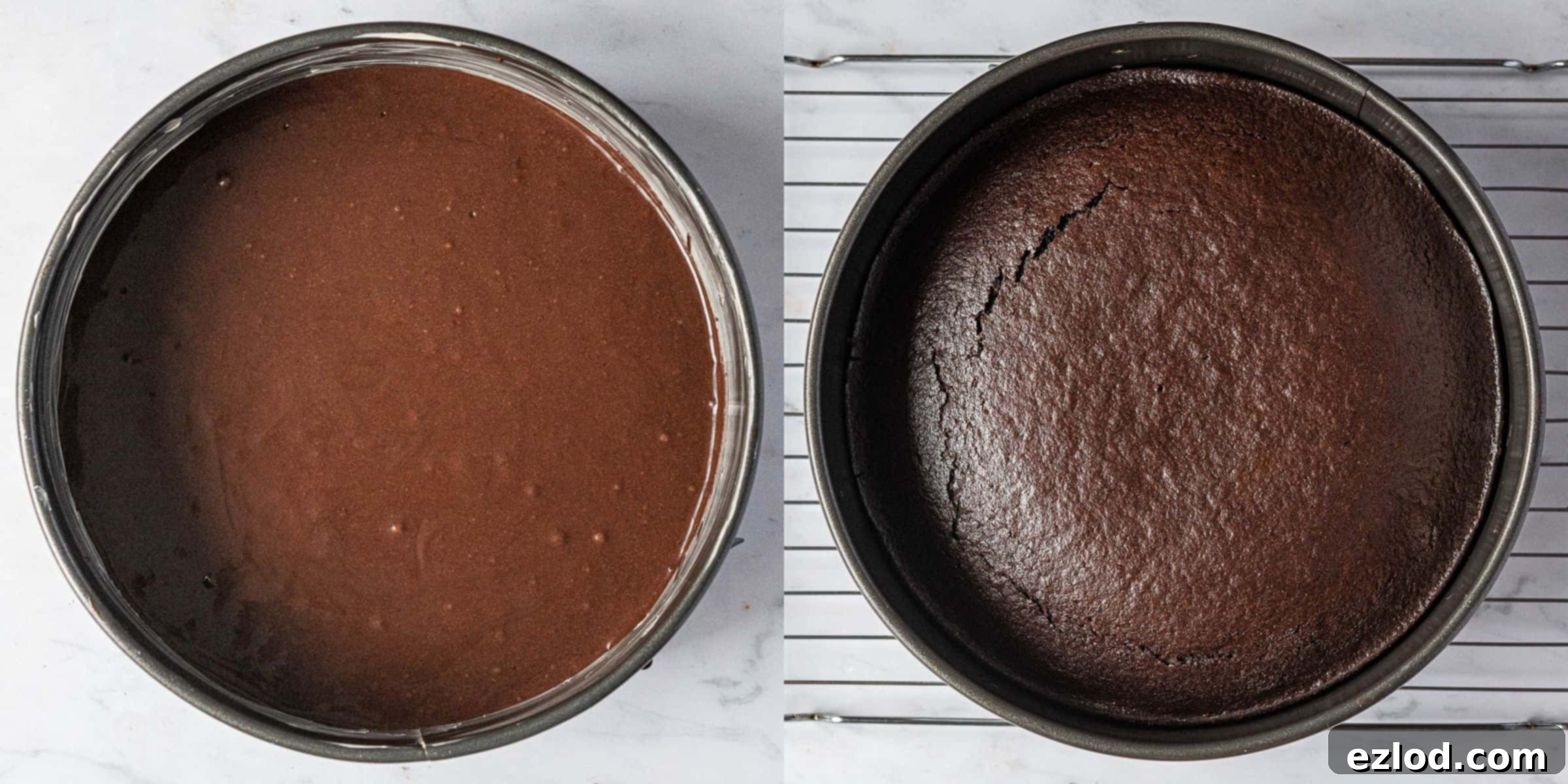
Once the cake is completely cool, prepare the springform tin by lining its sides with acetate or a double layer of greaseproof paper, ensuring it extends well above the top of the tin. This collar will help contain the mousse layers as they set. Carefully place the cooled chocolate cake back into the lined tin. If you desire perfectly flat mousse layers, you can trim the top of the cake to be perfectly level at this stage.
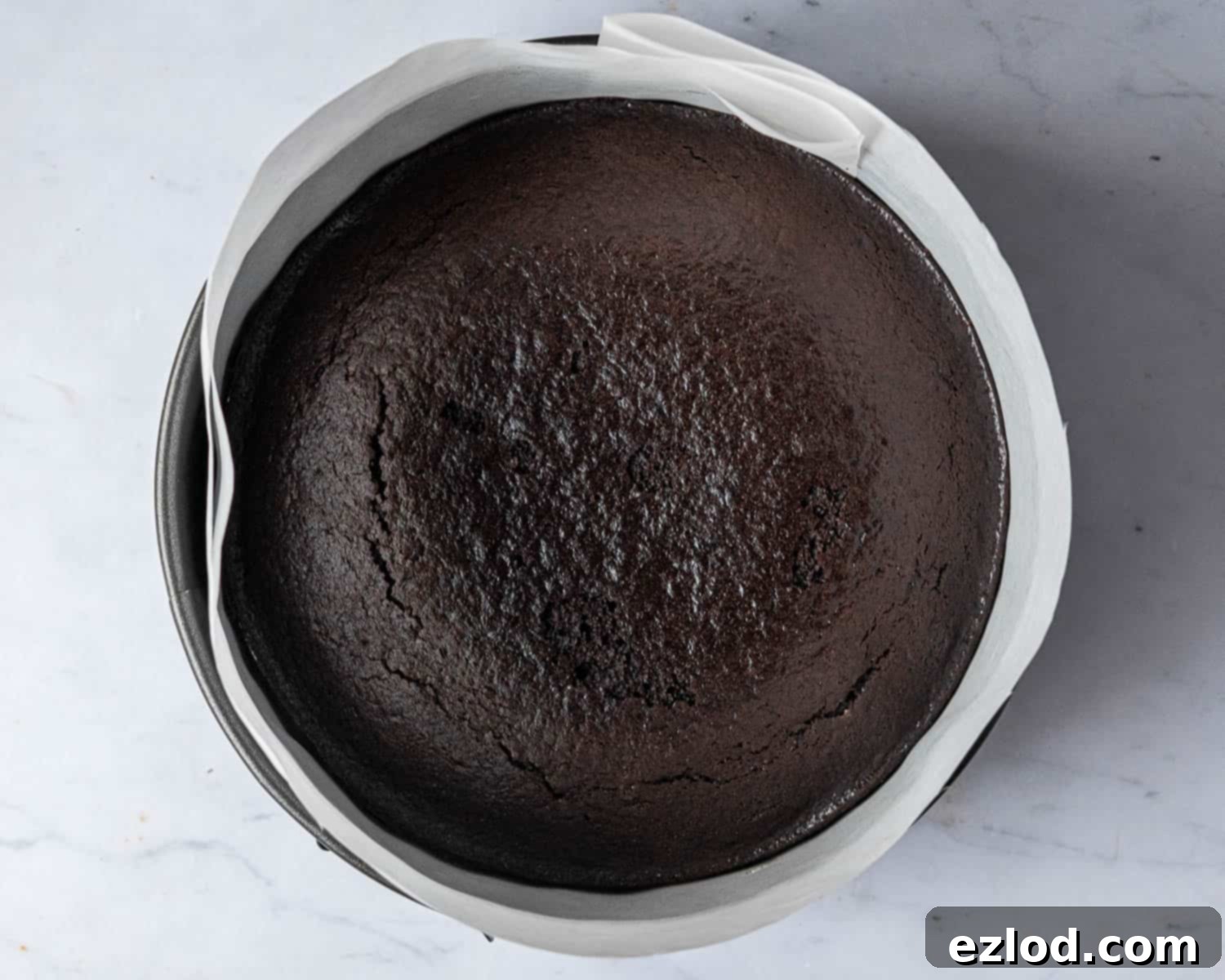
Preparing the Velvety Dark Chocolate Mousse:
To make the luscious dark chocolate mousse, start by heating the vegan whipping cream and vanilla extract in a saucepan until it just begins to simmer, but do not let it boil vigorously. Pour this hot cream over your finely chopped dark chocolate. Let it sit undisturbed for about 5 minutes to allow the chocolate to melt, then gently stir until the mixture is completely smooth and glossy, forming a beautiful ganache. Set this aside to cool to room temperature.
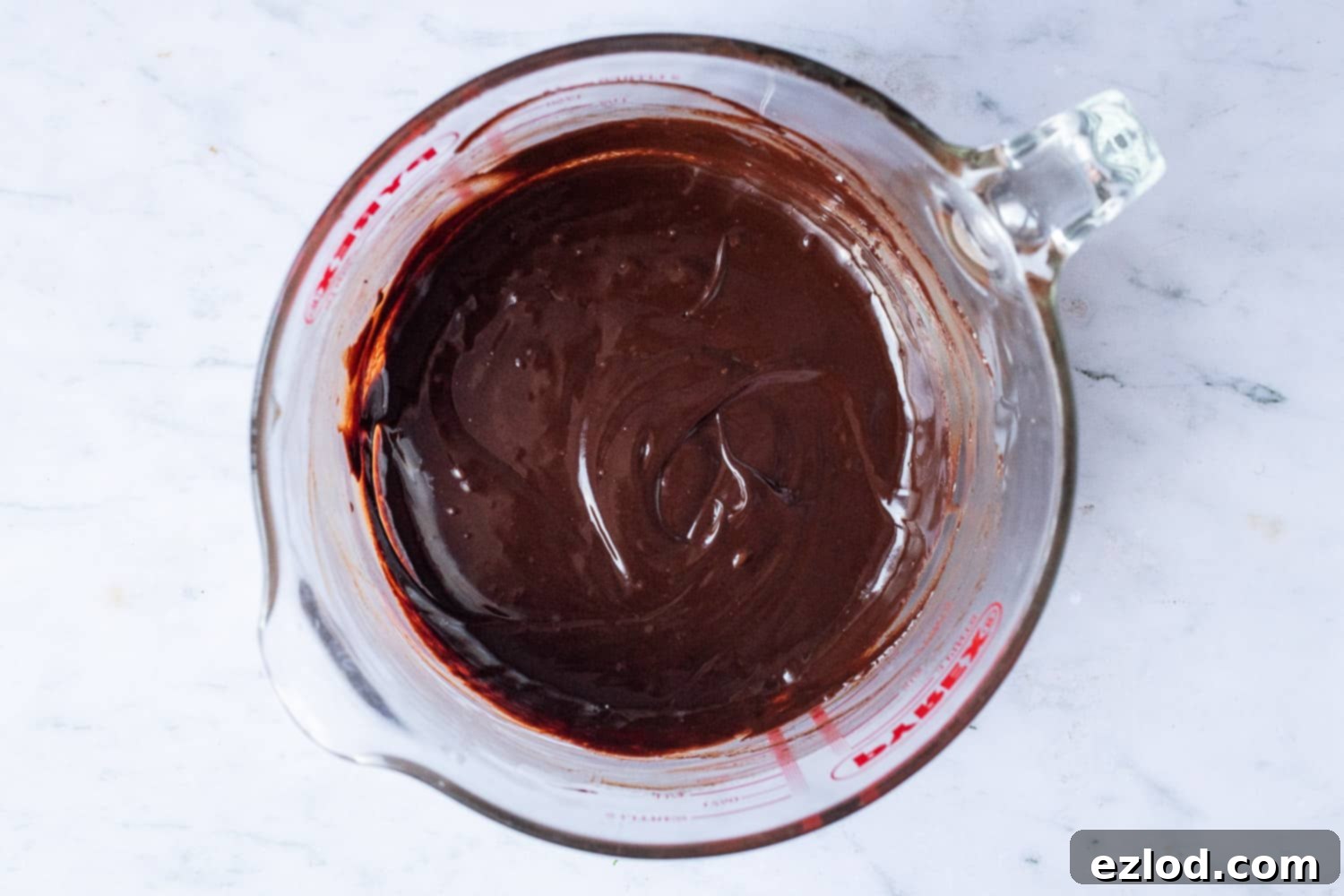
While the chocolate ganache cools, turn your attention to the aquafaba. Place the cold aquafaba and cream of tartar in the bowl of a stand mixer fitted with a balloon whisk, or use a hand mixer with double beater attachments. Whisk the aquafaba on high speed until it becomes frothy. Gradually add the caster sugar, one spoonful at a time, whisking well after each addition until the sugar is fully incorporated. Continue whisking until the aquafaba forms stiff, glossy peaks, similar to meringue.
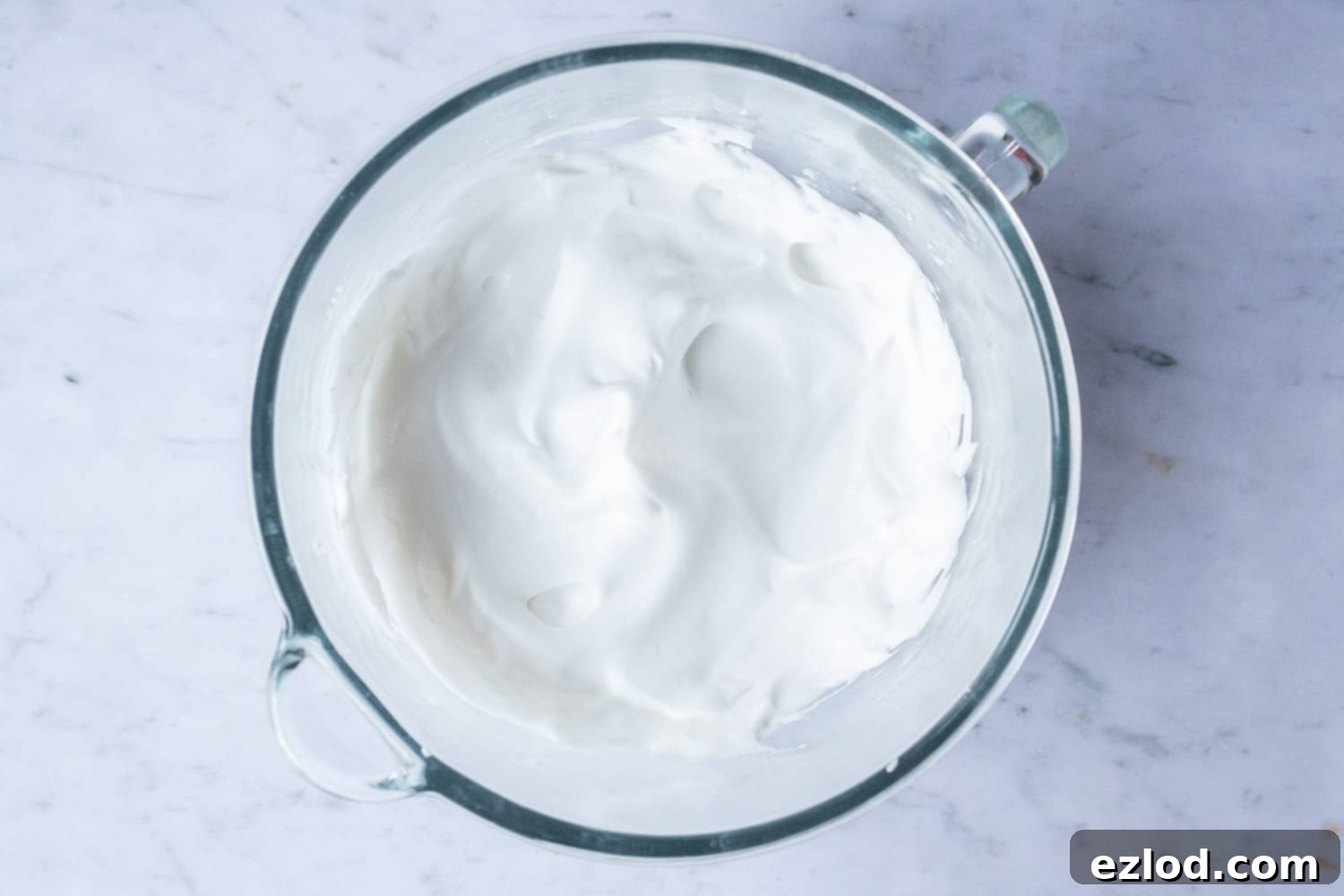
Once your chocolate ganache has cooled to room temperature, gently incorporate the whipped aquafaba. Start by adding about a quarter of the aquafaba to the chocolate mixture and stir it gently with a spatula until it’s almost combined. Then, add the remaining aquafaba in three more batches, folding it in very carefully. The goal is to combine the mixtures uniformly without deflating the airy aquafaba. Once fully combined, gently pour this mousse over the chocolate cake in the prepared tin. Transfer it to the fridge and allow it to set for at least 2 hours.
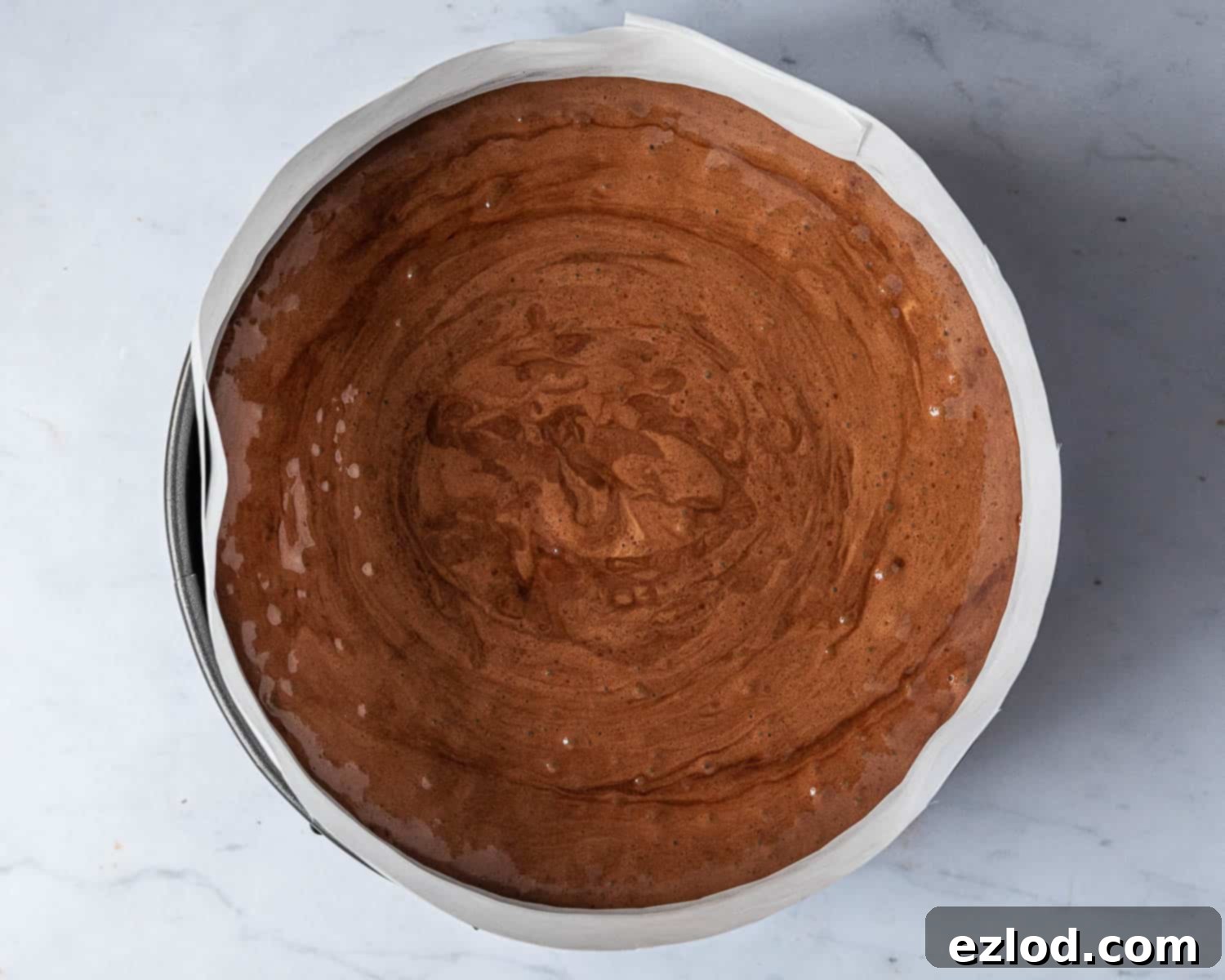
Crafting the Tangy Raspberry White Chocolate Mousse:
With the dark chocolate mousse setting, you can begin preparing the vibrant raspberry white chocolate mousse. Start by blending the defrosted frozen raspberries (along with any juices) and lemon juice until completely smooth. To achieve a perfectly silky mousse, press this raspberry puree through a fine-mesh sieve to remove all the seeds. Make sure to press down firmly on the pulp to extract as much of the flavorful puree as possible.
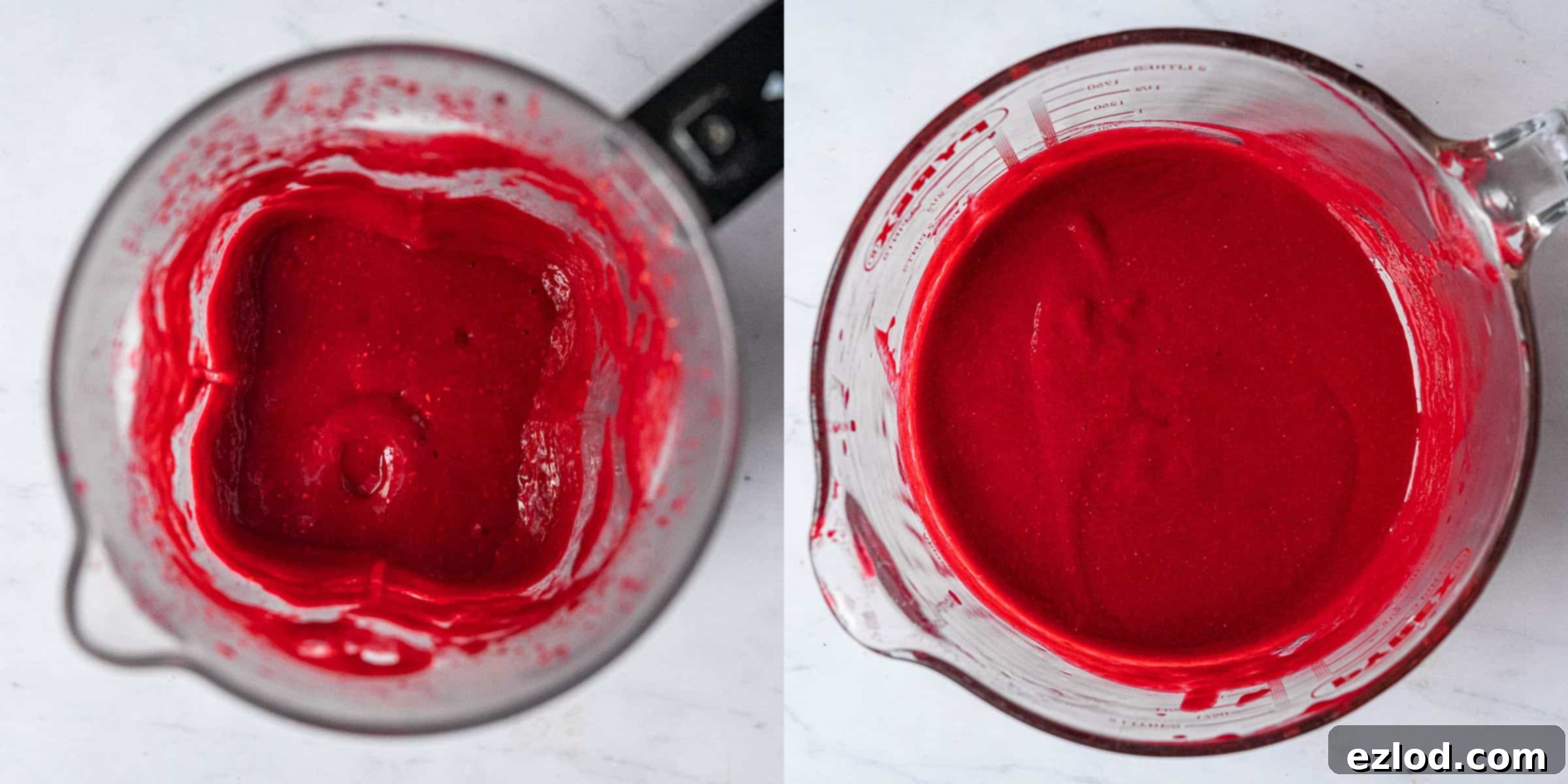
Place the seedless raspberry puree in a saucepan and bring it to a gentle simmer. Allow it to cook and reduce by at least half for 5-10 minutes, stirring frequently to prevent it from sticking to the bottom. This reduction concentrates the raspberry flavor intensely.
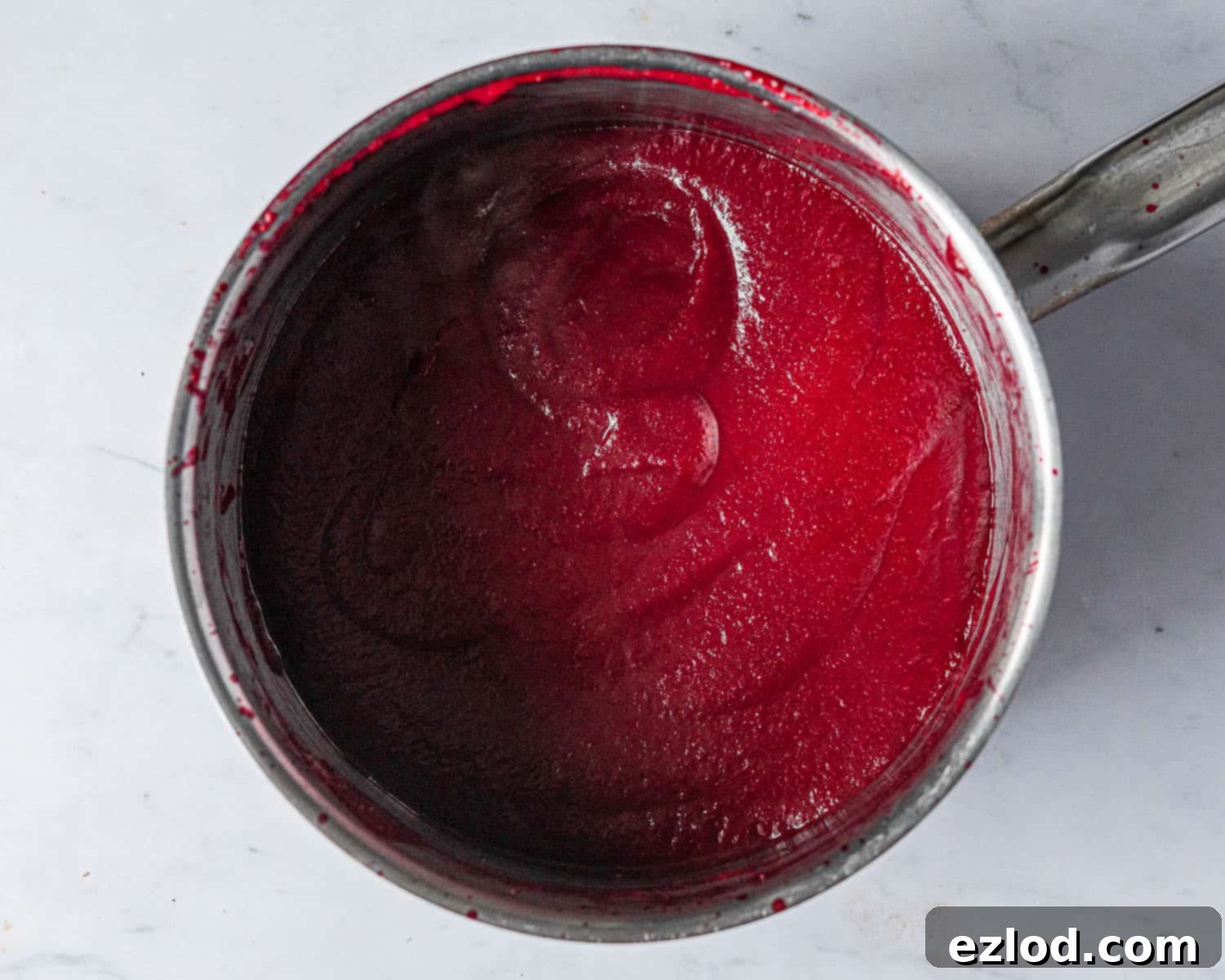
Measure out 150g of the reduced raspberry puree and place it back in a clean saucepan. In a small bowl, mix the agar agar powder with 1 tablespoon of cold water until smooth. Whisk this agar agar mixture into the raspberry puree in the saucepan. Bring the mixture to a boil and cook, whisking constantly, for 2 minutes. This step is crucial for activating the agar agar and ensuring the mousse will set.
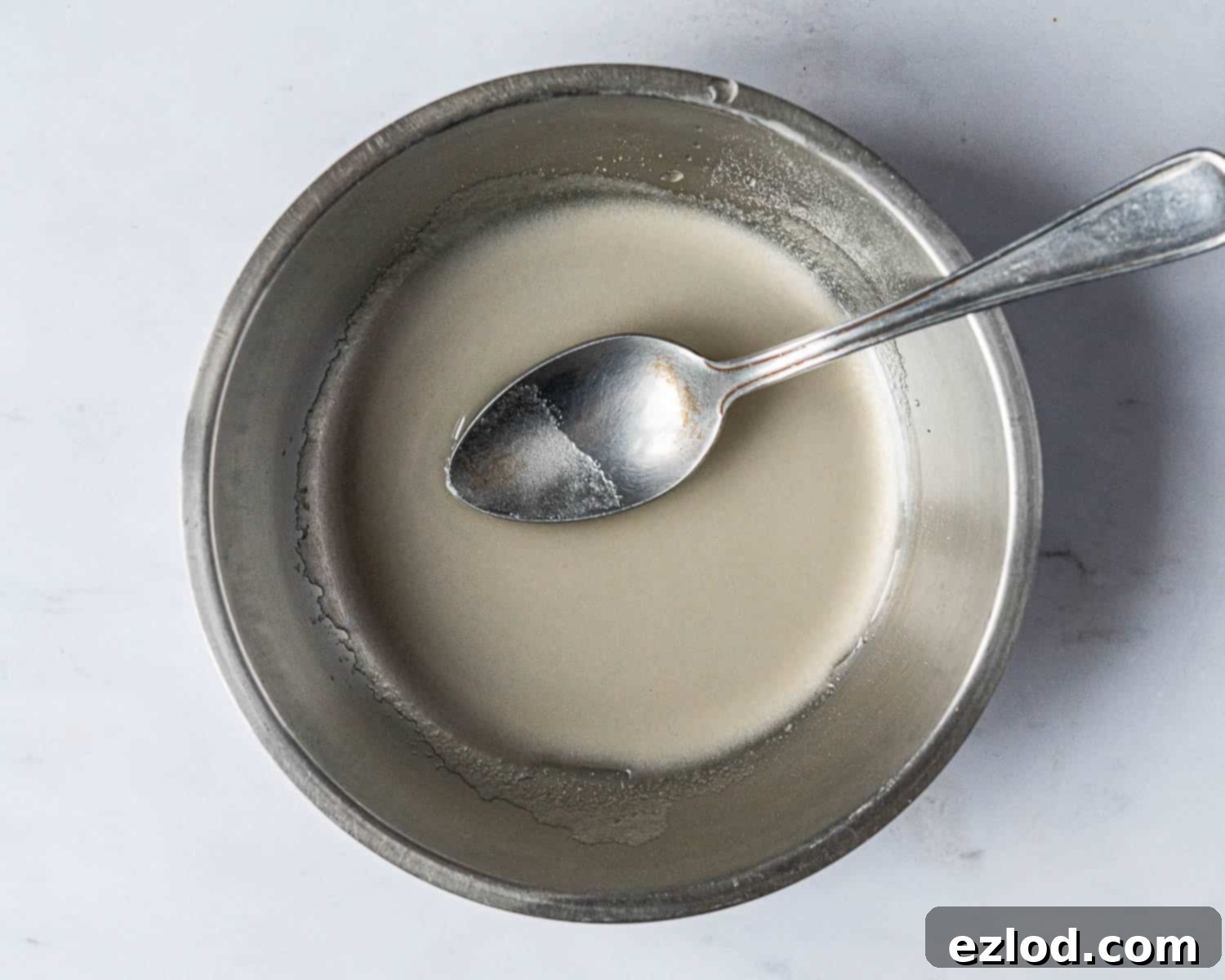
Pour the hot, agar-infused raspberry puree over the finely chopped vegan white chocolate, ensuring the chocolate is fully submerged. Let it sit for 5 minutes, then stir gently until the chocolate is completely melted and the mixture is smooth. Set this aside to cool to lukewarm. Be careful not to let it get too cold, as the agar agar will begin to set.
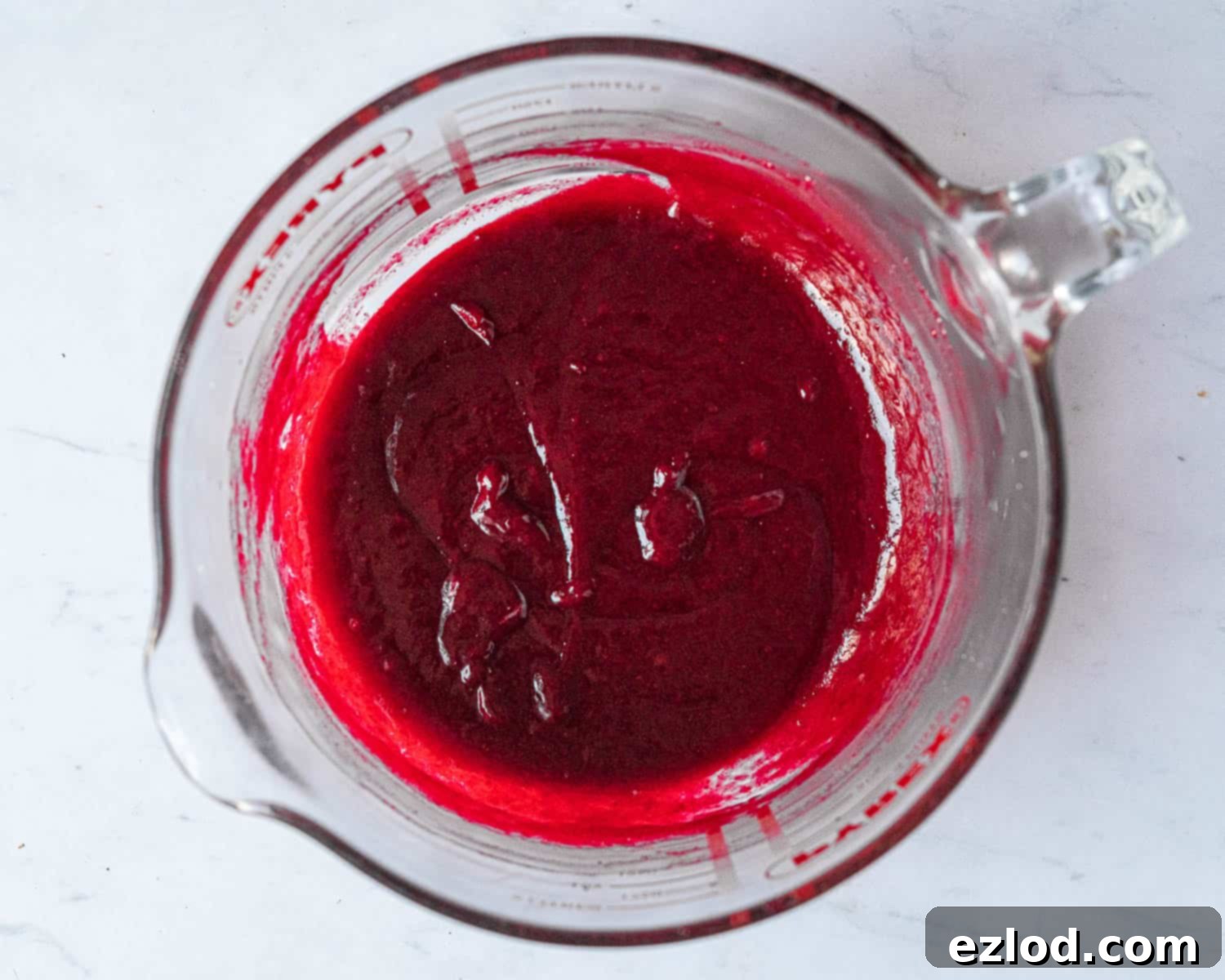
In a separate bowl, whisk the remaining vegan whipping cream and icing sugar with an electric mixer until it forms soft peaks. This usually takes longer than whipping dairy cream, so be patient and continue whisking until the desired consistency is achieved.
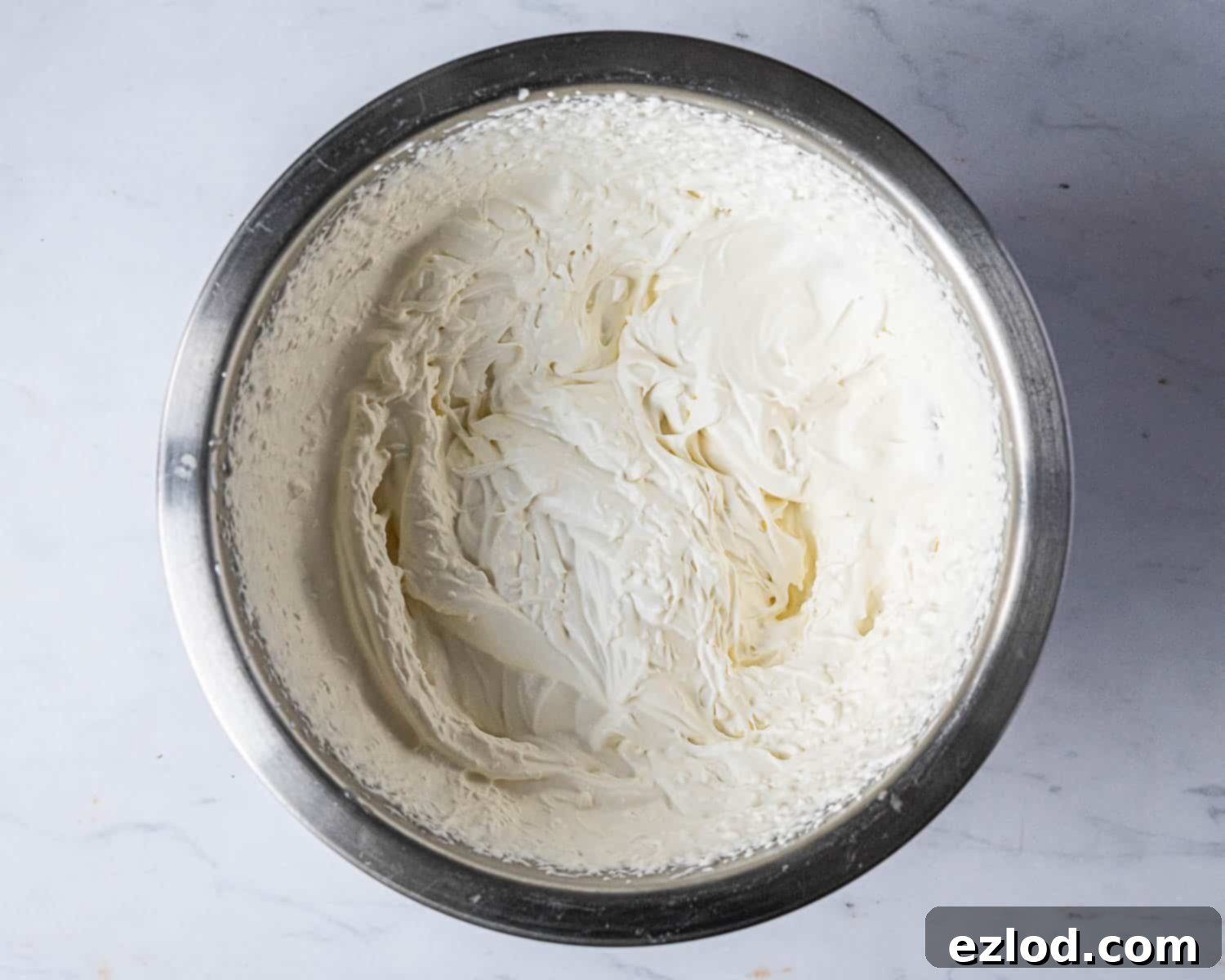
Gently whisk about a third of the whipped cream into the lukewarm raspberry mixture to lighten it. Then, carefully fold in the remaining cream using a spatula. Again, work gently to preserve the air in the cream, ensuring your mousse remains light and fluffy. Pour this exquisite raspberry mousse over the set chocolate mousse layer in the tin and spread it evenly. Refrigerate the cake for at least 4 hours, or ideally overnight, until both mousse layers are completely set.
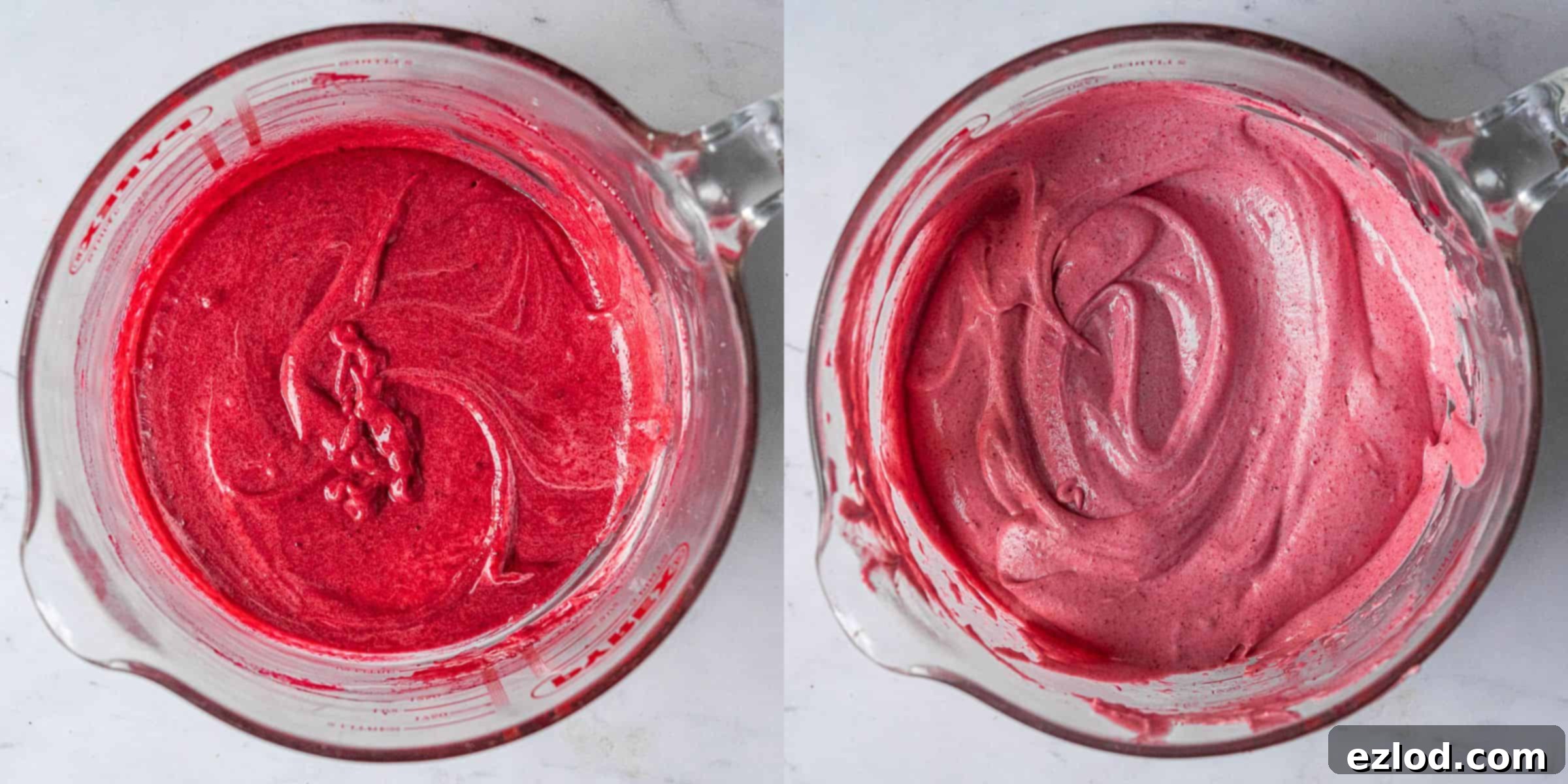
Once fully set, your stunning Vegan Chocolate Raspberry Mousse Cake is ready to be unveiled. Carefully unclip the springform tin and gently peel away the acetate or greaseproof paper collar. Garnish with fresh raspberries or chocolate curls if desired, and prepare for gasps of admiration!
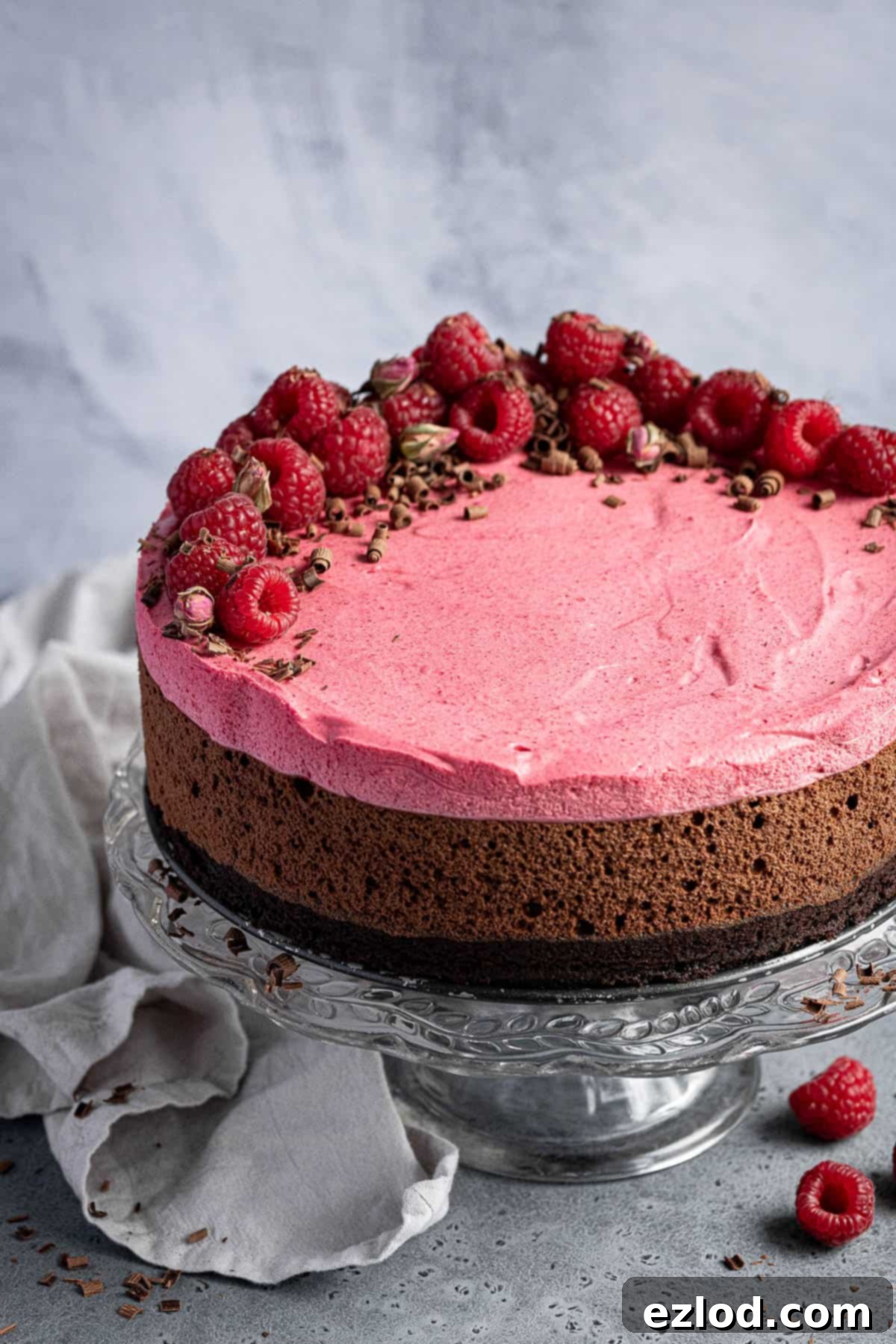
Essential Tips for Mousse Cake Perfection:
Creating a layered mousse cake can feel intricate, but with these expert tips, you’ll achieve professional-looking and tasting results every time:
- **Read the Recipe Thoroughly:** Before you begin, take the time to read through the entire recipe, including all instructions and notes. This helps you understand the process, gather all necessary ingredients and equipment, and anticipate the chilling times required.
- **Embrace Metric Measurements:** For superior accuracy and consistent baking results, I strongly advocate for using metric measurements with a digital kitchen scale over volumetric cup conversions. Cups can be highly inaccurate and lead to variations in your final product. A scale ensures precision, which is particularly important for delicate recipes like mousse cakes.
- **Stick to the Recipe:** For the best possible outcome, follow the recipe precisely as written. Vegan baking, especially with mousses, relies on specific ingredient ratios and techniques. Altering ingredients or proportions without understanding the chemical reactions involved can significantly impact the texture and stability of the cake. Any substitutions should be made at your own risk, as I cannot guarantee their success.
- **Plan Ahead for Chilling Time:** This vegan chocolate raspberry mousse cake requires significant chilling time for each layer to set properly. It’s not an “active” time, but it means the cake will take approximately a full day to complete. I highly recommend starting it the day before you plan to serve it, or at least beginning very early in the morning, to allow ample setting time.
- **Essential Equipment:** You will need a 23cm/9in springform cake tin. Crucially, it must be **at least** 7cm (2 ¾ inches) deep, as the mousse layers will fill the tin almost to the very top, or even slightly above. Using an acetate collar or a double layer of greaseproof paper around the inside of the tin is vital to ensure clean edges and easy release. If you wish to serve the cake directly off the tin’s base, it’s fine. However, if you want to remove the entire cake to a serving platter, place a 23cm/9in round cake board at the bottom of the tin before adding the cake layer. This makes transferring the finished cake much easier.
Mastering Aquafaba Reduction:
If you’re not using a commercially prepared, reduced aquafaba (like Oggs), I highly recommend reducing it yourself. This process significantly improves its stability and consistency, making it much easier to whip into stiff, voluminous peaks comparable to egg whites. For best results, reduce it the day before you plan to use it and allow it to chill thoroughly in the refrigerator overnight. Cold aquafaba whips best.
To reduce aquafaba: Drain the liquid from two cans of chickpeas into a saucepan. Bring the liquid to a gentle simmer over medium-low heat. Continue to cook gently for about 10-15 minutes, or until the volume has reduced by approximately half. The liquid will thicken noticeably as it cools. Once reduced, pour the aquafaba into an airtight container and refrigerate it until it’s completely cold before whisking.
Troubleshooting Chocolate Seizing: Prevention and Rescue:
While the vegan dark chocolate mousse is straightforward to make, chocolate can be finicky. Understanding how to prevent seizing and what to do if it happens is a valuable skill for any baker:
- **Temperature Control is Key:** When heating the vegan cream for your ganache, ensure it’s just simmering – a gentle bubbling around the edges – and not boiling rapidly. Overheated cream can cause the chocolate to seize, resulting in a grainy or oily texture. If possible, stick with a reliable vegan whipping cream like Elmlea plant cream, as some coconut creams can be more prone to splitting.
- **Patient Melting:** Pour the hot cream over your finely chopped chocolate. Resist the urge to stir immediately! Let it sit undisturbed for at least five minutes. This allows the heat from the cream to gently melt the chocolate. After five minutes, stir very gently from the center outwards until the mixture is smooth and emulsified.
- **How to Rescue Seized Chocolate:** Don’t despair if your ganache becomes grainy or oily (seizes)! It can often be saved.
- **Hot Water Method:** Vigorously stir in hot water, one teaspoon at a time, until the ganache becomes smooth again. Be cautious not to add more than four teaspoons of water, as excessive liquid can make your mousse too soft.
- **Cocoa Butter or Coconut Oil:** If hot water isn’t enough, try stirring in a small amount of melted cocoa butter (if you have it) or coconut oil. Add it a spoonful at a time and stir vigorously until the ganache re-emulsifies and becomes smooth.
- **Immersion Blender:** As a last resort, an immersion blender can work wonders. Carefully blend the seized ganache. The high-speed blending can help to re-emulsify the fats and liquids, restoring a smooth texture.
Storage Instructions for Your Mousse Cake:
This magnificent cake is best enjoyed fresh, but it can be stored to savor over a few days. Keep the Vegan Chocolate Raspberry Mousse Cake in an airtight container in the refrigerator for up to four days. To preserve its delicate flavors and prevent it from absorbing fridge odors, it’s highly recommended to store it under a cake dome. Unfortunately, this type of mousse cake does not freeze well due to the texture changes that occur with both the mousse and the cake base upon thawing.
Discover More Vegan Dessert Recipes:
If you loved this decadent vegan mousse cake, be sure to explore more of our delightful plant-based dessert creations:
- Vegan Sticky Toffee Pudding
- Vegan Tiramisu
- Steamed Chocolate Pudding
- Vegan Pecan Pie
- Vegan Peanut Butter Chocolate Tart
- Vegan Lemon Tart
- Vegan Lemon Blueberry Cheesecake
- Vegan Pumpkin Pie
- Vegan Strawberry Coconut Tart
- Vegan Bakewell Tart
- Steamed Maple Syrup Pudding
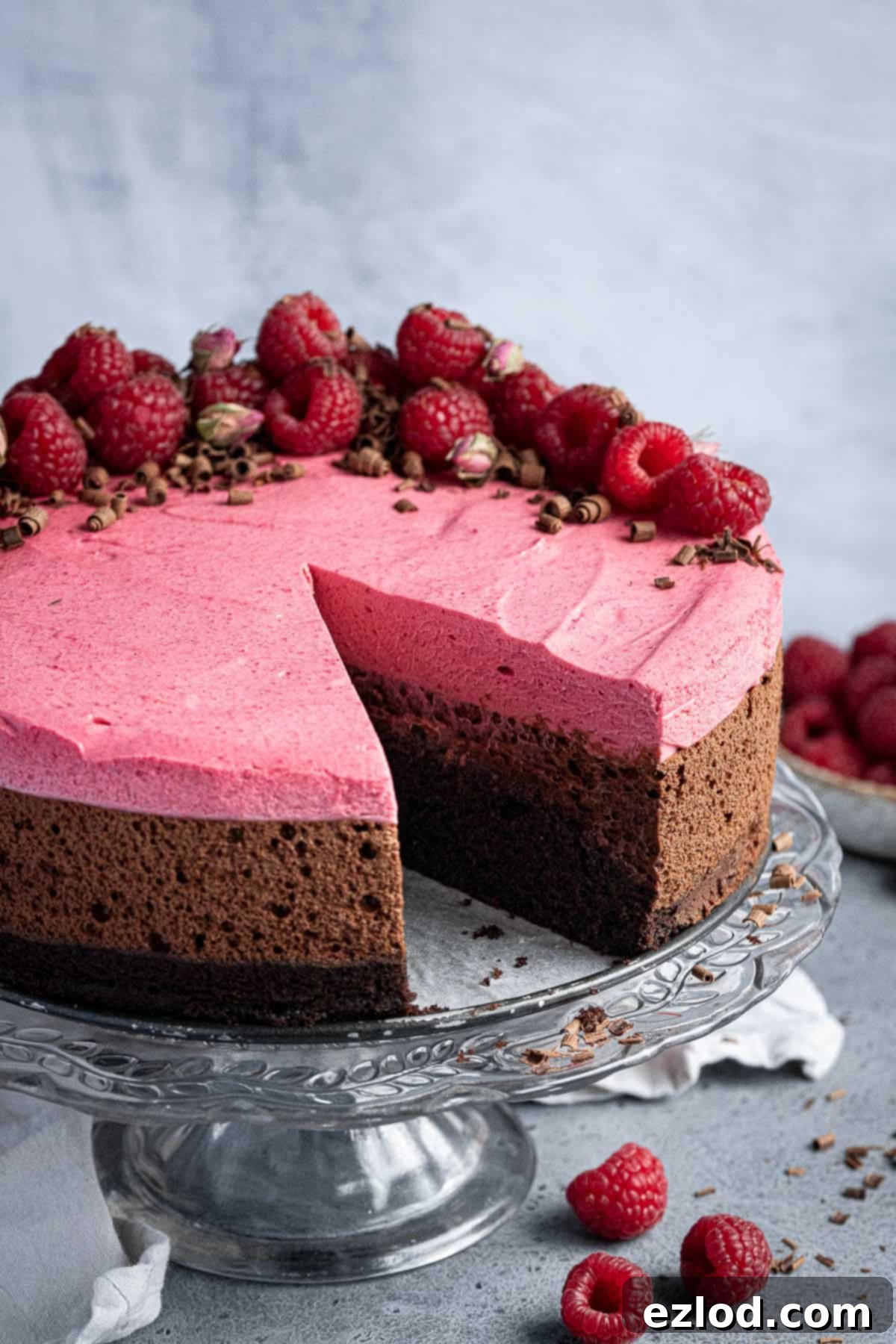
If you tried this recipe, we’d love to hear from you! Please rate it, leave a comment below, or tag @domestic_gothess on Instagram and use the hashtag #domesticgothess. Your feedback inspires us!
All images and content on Domestic Gothess are copyright protected. If you wish to share this recipe, please do so by using the provided share buttons. Do not screenshot or post the recipe or content in full; instead, kindly include a link back to this original post for the recipe details.

Print Recipe
Vegan Chocolate Raspberry Mousse Cake
Ingredients
Chocolate Cake:
- 200 ml (½ + ⅓ cup) unsweetened non-dairy milk (I use soy)
- 80 ml (⅓ cup) neutral oil (such as sunflower)
- 1 teaspoon vinegar
- 140 g (⅔ cup) caster (superfine) sugar
- 1 teaspoon vanilla extract
- 130 g (1 cup + 1 Tablespoon) plain (all-purpose) flour
- 45 g (4 ½ packed Tablespoons) cocoa powder
- ½ teaspoon baking powder
- ½ teaspoon bicarbonate of soda (baking soda)
- pinch salt
Chocolate Mousse:
- 200 g (7 oz) dark chocolate (no more than 70% cocoa solids, very finely chopped)
- 120 ml (½ cup) vegan whipping cream (I recommend using Elmlea Plant double cream)
- 1 teaspoon vanilla extract
- 120 ml (½ cup) reduced and cooled or shop bought aquafaba (I use Oggs, cold)*
- ¼ teaspoon cream of tartar
- 3 Tablespoons caster (superfine) sugar
Raspberry White Chocolate Mousse:
- 170 g (6 oz) vegan white chocolate (very finely chopped)
- 450 g (1 lb) frozen raspberries (defrosted)
- 1 Tablespoon lemon juice
- ½ teaspoon agar agar powder (NOT flakes)
- 1 Tablespoon water
- 240 ml (1 cup) vegan whipping cream (I recommend using Elmlea Plant double cream, cold)
- 1 Tablespoon icing (powdered) sugar
Instructions
Chocolate Cake:
-
Preheat the oven to 180°C/160°C fan/350°F/gas mark 4. Grease a 23 cm/9 in round, at least 7 cm/2 ¾ in deep springform cake tin and line it with baking parchment.
-
Whisk together the milk, oil, vinegar, caster sugar and vanilla extract until very well combined.
-
In a large bowl sift together the plain flour, cocoa powder, baking powder, bicarbonate of soda and salt.
-
Pour the wet ingredients into the dry and whisk with a balloon whisk until no dry lumps remain, but be careful not to over-beat the batter.
-
Pour the batter into the prepared tin, spread it level and bake for about 20-25 minutes until a skewer inserted into the centre comes out clean.
-
Allow the cake to cool in the tin for 10 minutes then carefully turn it out onto a wire rack and leave to cool completely.
-
Wash the tin and line it with a strip of acetate or a double layer of greaseproof paper, making sure that it comes at least 5 cm/2 in above the top of the tin. If you have a 23 cm/9 in cake board then it is a good idea to place that in the bottom. If not then just line the base with baking parchment.
-
Place the cold cake back in the lined tin. If you want perfectly flat layers of cake and mousse then you can trim the top to level it first (I didn’t bother).
Chocolate Mousse:
-
Place the finely chopped dark chocolate in a large heat-proof bowl. Heat the cream and vanilla extract until it is just simmering (don’t let it boil) then pour it over the finely chopped chocolate.
-
Let it sit for 5 minutes then stir gently until smooth and glossy. (See post above for what to do if it splits). Set aside to cool to room temperature. (If there are still a few lumps of melted chocolate then you can heat it in 10 second bursts in the microwave, stirring after each one, until it is melted).
-
While the ganache is cooling, place the aquafaba and cream of tartar in the bowl of a stand mixer fitted with a balloon whisk; or use a hand mixer with the double beater attachments.
-
Whisk the aquafaba on a high speed until it is frothy, add a spoonful of the sugar and whisk until well combined; repeat until you have added all of the sugar. Continue to whisk the aquafaba until it forms stiff peaks.
-
Make sure that the chocolate mixture has cooled to room temperature then add ¼ of the whipped aquafaba to the chocolate and stir gently with a spatula until almost combined.
-
Add the rest of the aquafaba in three more batches, folding it in very gently until it is uniformly combined. You don’t want there to be any streaks of chocolate or aquafaba, but don’t keep mixing for too long, you don’t want to deflate the mousse. (It will lose a bit of volume however and become slightly more runny – don’t worry, this is normal).
-
Gently pour the mousse over the top of the cake in the tin, then place it in the fridge for at least 2 hours to set.
Raspberry White Chocolate Mousse:
-
Place the finely chopped white chocolate in a large, heat-proof bowl.
-
Blend the defrosted frozen raspberries (plus any juices) and the lemon juice until smooth.
-
Press the puree through a fine mesh sieve to remove the seeds. Really press down on the pulp to extract as much of the puree as possible. Discard the seeds.
-
Place the puree in a saucepan and bring up to a simmer. Cook until it has reduced by at least half, 5-10 minutes. Stir often to prevent it from catching.
-
Weigh out 150g (½ cup + 2 Tablespoons) of the reduced puree and place it in a saucepan. Mix the agar agar with 1 Tbsp cold water. Whisk the agar mixture into the puree.
-
Bring up to the boil and cook for 2 minutes, whisking constantly. It will be quite thick.
-
Pour the puree over the chopped white chocolate, making sure it is fully covered. Leave for 5 minutes, then stir until melted and smooth. Set aside until lukewarm (don’t let it get too cold however or the agar agar will set). (If there are still a few lumps of melted chocolate then you can heat it in 10 second bursts in the microwave, stirring after each one, until it is melted).
-
Whisk the cream and icing sugar with an electric mixer until it forms soft peaks. This takes a fair bit longer than dairy cream.
-
Gently stir ⅓ rd of the cream into the raspberry mixture with a balloon whisk, then carefully fold in the rest of the cream with a spatula. There shouldn’t be any streaks of cream or raspberry but be very gentle so as not to knock out the air.
-
Pour the raspberry mousse over the chocolate mousse and spread level. It will probably come all the way up to the top of the tin, or even slightly above. Refrigerate for at least 4 hours, or overnight, until set.
-
To serve, unclip the springform tin and remove the rim. Place the cake on a serving plate. If you didn’t have a cake board to place in the tin then you will probably have to leave it on the base of the tin as it is delicate and will be difficult to remove. Gently peel off the acetate/greaseproof paper.
-
Decorate the top of the cake as you like with fresh raspberries and chocolate curls. Store in the fridge, preferably inside a cake dome, until you are ready to serve. It will keep for up to 4 days.
Notes
- *Refer to the “Mastering Aquafaba Reduction” section above for detailed instructions on how to reduce aquafaba.
- This is a fairly complex cake, so ensure you read through the recipe fully before commencing any steps.
- For consistent and reliable baking outcomes, I strongly recommend using metric measurements with a digital scale rather than cup conversions, which can be imprecise.
- Achieving the best results means following the recipe closely. Ingredient substitutions may alter the cake’s outcome, and any changes are made at your own discretion.
- This cake requires approximately a full day to prepare and set, primarily due to the necessary cooling and chilling times between layers. Plan to make it the day before serving or start early in the morning.
- For additional tips, detailed explanations, and visual step-by-step photos, please refer to the sections preceding this recipe card.
